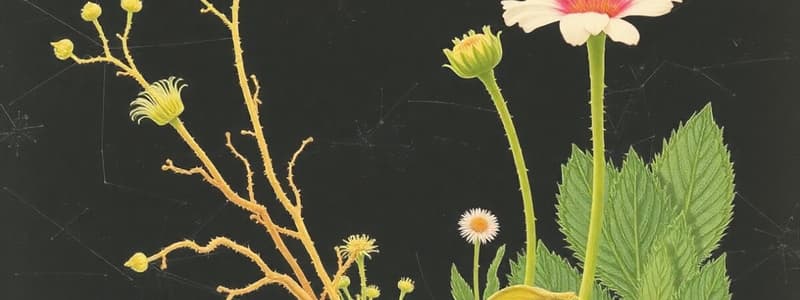Podcast
Questions and Answers
What is the primary function of rhizoids in bryophytes?
What is the primary function of rhizoids in bryophytes?
- Photosynthesis
- Anchoring the organism and nutrient uptake (correct)
- Air exchange
- Pollination
Which of the following statements about bryophytes is true?
Which of the following statements about bryophytes is true?
- Bryophytes grow only in dry environments.
- Bryophytes are vascular plants.
- Bryophytes lack structures for water absorption.
- Bryophytes evolved approximately 500 million years ago. (correct)
How do rhizoids compare to roots found in vascular plants?
How do rhizoids compare to roots found in vascular plants?
- Rhizoids are specialized structures for standing upright.
- Rhizoids can store nutrients similarly to roots.
- Rhizoids are shorter, thinner, and simpler structures. (correct)
- Rhizoids are multicellular like roots.
What is one primary function of rhizoids in bryophytes?
What is one primary function of rhizoids in bryophytes?
In which part of bryophytes are rhizoids typically located?
In which part of bryophytes are rhizoids typically located?
In what type of environment are bryophytes typically found?
In what type of environment are bryophytes typically found?
How do bryophytes primarily absorb water?
How do bryophytes primarily absorb water?
What characteristic do bryophytes lack compared to vascular plants?
What characteristic do bryophytes lack compared to vascular plants?
Which statement about the structure of rhizoids is correct?
Which statement about the structure of rhizoids is correct?
Which body parts are present in bryophytes?
Which body parts are present in bryophytes?
What differentiates the rhizoids of various bryophyte species?
What differentiates the rhizoids of various bryophyte species?
Which of the following explains why bryophytes require water for survival?
Which of the following explains why bryophytes require water for survival?
What distinguishes non-vascular plants like bryophytes from vascular plants?
What distinguishes non-vascular plants like bryophytes from vascular plants?
What must bryophytes maintain for proper function?
What must bryophytes maintain for proper function?
In liverworts, how are rhizoids described?
In liverworts, how are rhizoids described?
Study Notes
Rhizoids: Definition and Function
- Rhizoids are short, thin filaments or hair-like structures found in bryophytes (mosses, liverworts, hornworts), some fungi, and algae.
- Their primary functions are anchoring the organism to a substrate and absorbing water and nutrients.
- Unlike the roots of vascular plants, rhizoids are not multicellular and lack specialized tissues for structural support. They require direct contact with water for survival.
- Rhizoid structure varies: some are unicellular (hornworts, liverworts), others multicellular (mosses). They can be branched, smooth, bumpy, horned, or have tubers for nutrient storage. Colors range from translucent to green or purple.
Rhizoids in Bryophytes
- In bryophytes, rhizoids emerge from the base of the gametophyte (the non-reproductive part of the plant).
- Water and nutrient uptake in bryophytes occurs via capillary action, osmosis, diffusion, and active transport. This requires constant contact with moisture.
- Bryophyte rhizoids are crucial for identification due to their diversity in structure and appearance.
Rhizoids in Specific Bryophyte Examples
- Mosses: Usually have multicellular rhizoids, primarily for anchorage. Water and nutrient absorption occurs mainly through the leaf-like structures. There are 10,000-12,000 moss species globally, ranging in size from microscopic to several feet.
- Liverworts: Approximately 7,000 species, with rhizoids used for anchorage and water/nutrient uptake. Rhizoids can be smooth or pegged. The name derives from the liver-like appearance of their lobed structures.
Comparison to Vascular Plant Roots
- Vascular plant roots are multicellular structures with specialized tissues (xylem and phloem) for water and nutrient transport. They contain lignin for structural support, allowing for growth independent of direct water contact.
- Bryophytes lack these specialized tissues and require direct water contact for survival, explaining their preference for moist environments. Rhizoids, while functionally similar to root hairs in some aspects, differ significantly in structure and complexity.
Studying That Suits You
Use AI to generate personalized quizzes and flashcards to suit your learning preferences.
Description
Explore the fascinating world of rhizoids and their role in bryophytes such as mosses, liverworts, and hornworts. This quiz covers their structure, functions, and differences from plant roots. Gain insights into how these structures help in anchoring and nutrient absorption.
